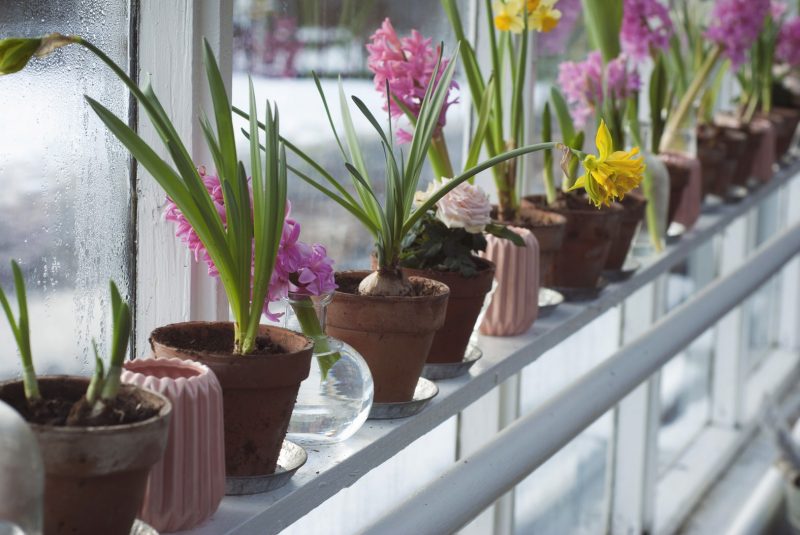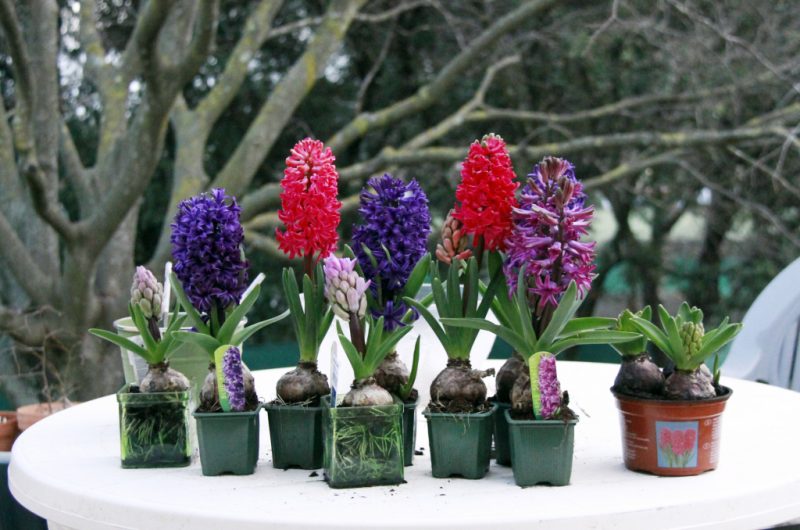Hyacinth is a symbol of spring, which, thanks to the ability to grow beautiful primroses on the windowsill, can knock on the house at any time of the year. Fragrant brush-shaped inflorescences of various colors against the background of a window decorated with frosty drawings are a fabulous spectacle, which you can easily witness by performing simple home hyacinth care in a pot.
Material Content:
Species and varieties are described.
Despite the fact that the genus in the wild is represented by 3 species, oriental hyacinth has become the basis for the cultivation of modern hybrids and varieties. The variety is represented by perennial bulbous plants up to 30 cm high. From the bulb, elongated, tapered leaves of a rich green color and an upright shoot develop, the top of which is crowned with a racemose consisting of 35 fragrant bell-shaped flowers. Bright flowering against the background of only emerging grass, noted in early spring, lasts up to two weeks and fills the air with an exquisite fragrance.

The most spectacular varietal and hybrid hyacinths:
- Borah - a variety with large lilac-blue inflorescences.
- Anna Marie is a light pink variety.
- Grand Blanche - is distinguished by a snow-white color of inflorescences, which are slightly cast with a pinkish-cream color.
- La Victoire - the variety is represented by plants with compact inflorescences consisting of raspberry flowers.
- Prince Arthur - stands out with double flowers.
Optimal conditions for growing
To grow a beautiful and healthy flower, hyacinth should be provided with the necessary conditions.

A hyacinth needs a low but wide enough capacity, which can accommodate several bulbs with a distance of 3 cm to form a spectacular bouquet. There should be good drainage holes at the bottom of the pot. Before filling the right dishes, a fertile, loose soil with a slightly acidic reaction is prepared by mixing turf, leafy soil, compost, humus, peat and sand in equal proportions.
Since hyacinths bloom in the natural environment when shrubs and trees have not yet formed a dense crown, the plant also needs a lot of soft light on the windowsill. On cloudy days it is recommended to illuminate the flower. In order for hyacinth to develop evenly, it is necessary to systematically turn the pot clockwise.
The temperature regime depends on the development phase: after exiting dormancy, the optimal values are 8 - 10 ° C, increasing by 10 degrees at the beginning of the formation of peduncles and flowering.
Additional humidification of the hyacinth is not required, since high humidity can lead to negative consequences - the beginning of the development of fungal diseases.
Features of home care
With all the recommendations, caring for hyacinth as a potted culture is quite simple. After all, it is not for nothing that the flower is the namesake of the hardy Spartan, from whose blood an elegant plant appeared.
Watering and spraying flowers
One of the important conditions for the successful cultivation of a flower in a pot is the organization of competent watering, in which the earthen lump will be constantly moistened, but without stagnation of moisture. It is important that when moistened, water does not get on the shoots, which from this can begin to rot. Hyacinth does not need spraying.

Advice! To water only wet the substrate, it should be poured near the edge of the tank.
Fertilizer and fertilizer
From the beginning of the development of the peduncle and until the end of flowering, the bulb should be fed with the nutrients contained in special liquid complexes for flowering plants. The interval between feeding during the active growing season is 15 days.
Read also:wisteria
How to care for hyacinth after flowering
Hyacinths faded in pots, what to do next?

After flowering is completed, in order to prolong the life of hyacinth, the following steps must be performed:
- Peduncles are cut.
- While the leaves fade naturally, the earthen soil is watered and enriched with mineral fertilizers.
- When the aboveground part wilts, the bulb is removed and cleaned of the remains of soil and foliage.
- Well-developed children are separated.
- The bulbs are dried and sent until the fall for storage in a cool dark room.
- In autumn, the bulbs that have demonstrated flowering in a pot are planted in the garden, where they will bloom next spring.
Attention! You cannot use the same bulb for two years in a row to distill the flowers in the pot.
Transplant and trim nuances
Since after flowering, the bulb continues to accumulate nutrients, only flower stalks with faded inflorescences are cut off. If the flower grower plans to distill hyacinths by a certain date, then the buds must be cut before flowering begins, which will not happen again without planting in the ground.

If the flower grower acquired hyacinth in a bulbous state or just threw out a flower stalk, then you can transplant hyacinth after purchase from a shipping container, adhering to the following scheme:
- A spacious pot is selected in which the drainage is placed.
- Next, a small amount of fertile substrate and a layer of sand, on which the bulb is placed, are filled up.
- Hyacinth is covered in such a way that the upper part is not covered by soil and interacts with air.
- If the bulb is purchased, then the container goes to the refrigerator for 1.5 months.
- A flower with sprouts organizes an artificial spring on a light windowsill.
Important! A flowering plant cannot be transplanted: with a high degree of probability it can die.
Protection against diseases and pests
Hardy flowers with systematic waterlogging and hypothermia can be affected by gray rot, the development of which can be stopped by normalizing the conditions of maintenance and processing of plants with fungicide, as well as bacterial. The last disease is incurable and it will not work to preserve the hyacinths affected by it.

Of the pests, stem nematodes, aphids and root mites are secreted, which must be dealt with by disinfecting the bulbs before planting and spraying the shoots with an insecticide.
Attention! Pesticide treatments are allowed before budding with preliminary soil protection.
Hyacinth propagation methods
In breeding institutes and in industrial floriculture, such propagation methods as seed, which does not preserve varietal qualities during home execution, and donut cutting can be used. At home, flower growers settled on a simple and effective method of breeding their favorite variety - separation of children.

When removing the bulb after flowering:
- Planting material is thoroughly cleaned, and those children are separated that, without damaging the maternal specimen, almost fall off themselves.
- Children who do not separate without effort remain with their mother's bulb for growing next year.
- Bulbs are treated with a fungicidal solution, dried and stored in a cool, dark place with a temperature of 5 ° C.
What problems can flower growers face?

If you violate the basic rules for the maintenance and care of a flowering plant, a gardener may experience the following problems:
- The leaves turn yellow. With inappropriate temperature and irrigation regimes, drafts, pest colonization, yellowing of the aboveground part of hyacinth can be observed.
- Fade foliage. The reason, as a rule, lies in the lack of lighting, which is provided artificially in the winter.
- The buds have fallen. Excessive watering or dropping water on the shoots will lead to the discharge of unformed flowers.
- Hyacinth does not bloom. The problem may be due to non-observance of the cyclical nature of the bulb in the pot and open ground or with a violation of the length of the dormant period, the duration of which is 1.5 - 2 months. If the time interval is too short, the bulb may not have time to rest and gain strength, and if it is too long, all the forces will be spent on the intensive formation of green mass to the detriment of flowering.
Thus, a gardener who bought a flowering hyacinth in a pot should not be in a hurry to throw it away after flowering, but he should be prepared for planting it in open ground.












